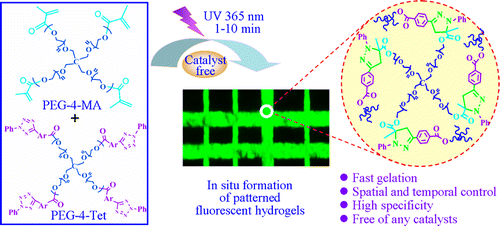In Situ Forming Hydrogels via Catalyst-Free and Bioorthogonal “Tetrazole–Alkene” Photo-Click Chemistry
Yaping Fan , Chao Deng *(邓超), Ru Cheng , Fenghua Meng , and Zhiyuan Zhong * (钟志远)
Biomedical Polymers Laboratory, and Jiangsu Key Laboratory of Advanced Functional Polymer Design and Application, College of Chemistry, Chemical Engineering and Materials Science, Soochow University, Suzhou 215123, People’s Republic of China
Biomacromolecules 2013, 14, 2814–2821.
In situ forming hydrogels were developed from 4-arm poly(ethylene glycol)–methacrylate (PEG-4-MA) and −tetrazole (PEG-4-Tet) derivatives through catalyst-free and bioorthogonal “tetrazole–alkene” photo-click chemistry. PEG-4-MA and PEG-4-Tet (Mn = 10 kg/mol) were soluble at 37 °C in phosphate buffer (PB, pH 7.4, 10 mM) at total polymer concentrations ranging from 20 to 60 wt % but formed fluorescent hydrogels upon 365 nm UV irradiation at an intensity of 20.6, 30.7, or 60 mW/cm2. The gelation times ranged from ca. 50 s to 5 min, and storage moduli varied from 0.65 to 25.2 kPa depending on polymer concentrations and degrees of Tet substitution in PEG-4-Tet conjugates. The cell experiments via an indirect contact assay demonstrated that these “tetrazole–alkene” photo-click PEG hydrogels were noncytotoxic. The high specificity of photo-click reaction renders thus obtained PEG hydrogels particularly interesting for controlled protein release. Notably, in vitro release studies showed that cytochrome c (CC), γ-globulins (Ig), and recombinant human interleukin-2 (rhIL-2) all were released from PEG hydrogels in a sustained and quantitative manner over a period of 14–20 days. Importantly, released CC and rhIL-2 exhibited comparable biological activities to native CC and rhIL-2, respectively. These results confirm that “tetrazole–alkene” photo-click reaction is highly compatible with these loaded proteins. This photo-controlled, specific, efficient, and catalyst-free click chemistry provides a new and versatile strategy to in situ forming hydrogels that hold tremendous potentials for protein delivery and tissue engineering.

链接: //pubs.acs.org/doi/abs/10.1021/bm400637s